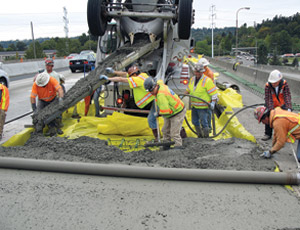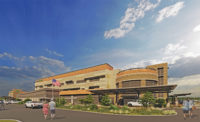For construction labor, the pain brought on by the recession is being felt in the paycheck. While unemployment remains historically high and contractor backlogs evaporate, most workers see limited increases in wages and fringes, and many are seeing wages frozen or even cut.

The outlook is similar for both open- shop and union contractors. Open-shop contractors expect to increase wages by an average of 1.84% this year, including firms that are giving no increase, according to the 2010 Merit Shop Wage and Benefit Survey compiled by Personnel Administration Services of Saline, Mich. Among union shops, wage and benefit settlements for the first three quarters of 2010 have yielded an average first-year increase of 1.3%, according to a September survey by the Construction Labor Research Council in Washington, D.C.
The tough numbers for 2010 follow an equally challenging 2009, when open- shop labor saw an average increase of 1.69%. Employment numbers haven’t improved significantly since 2009. In August, the Bureau of Labor Statistics reported that construction unemployment hit 17%, the highest on record for the month of August. In August 2009, the rate was 16.5%.
Jeff Robinson of PAS says that, while employers want to keep good workers in the fold, the economic outlook for the industry is keeping them on their guard.
“A lot of people I talk to say, ‘I just got this job,’ ” he says. “That gives people some hope. They want to be optimistic, but they remain cautious. Until the unemployment figures improve, things will remain flat. It’s a waiting game.”
With wage increases at such low levels and many firms freezing wages entirely, Robinson says there is growing concern workers will leave the industry, never to return. This year, around a third of open- shop contractors are expected to give no increases, which is on par with last year. Among those companies planning to raise wages this year, estimated increases average 2.87%, according to PAS.
Robinson says many workers may be willing to endure a temporary freeze, but some may soon lose patience with employers. “You can get away with [12 to 18 months] without rewarding employees, but after that, people start to move on,” he says. “Companies that are in their second year of freezes are in a tough spot.”
Although nearly every region in the country is reporting similar wage statistics, there are pockets of differences. Robinson says that, in Baton Rouge, where there are ongoing petroleum and industrial projects, only 8% of survey respondents reported wage freezes. Meanwhile, nearly 80% of firms in Boston froze wages.
Robinson notes that hourly labor is feeling the squeeze more than salaried employees. Open-shop companies estimate executives will see an average base- pay increase of 3.7% in 2010, while professional staff could see a roughly 2.9% increase in salary levels.
The unionized labor market isn’t faring much better. As settlements expire, union locals face tough negotiations. With first-year increases averaging 1.3%, the Construction Labor Research Council’s Bob Gasperow says unions have seen a dramatic drop following nearly a decade of increases that averaged, through 2008, about 4%.
“This is drastically less than we’ve seen in modern years,” he says. “We haven’t seen anything like this since the 1990s.”
Settlement terms are notably shorter. Gasperow says that, historically, 60% of agreements are for three-year periods. This year, 33% of agreements are for three years, while 57% are for one year.
Denise Gold, associate general counsel for labor and employment law for the Associated General Contractors of America, says the tough position for employers hasn’t gone unnoticed among union leaders. With competition high and profit margins low, many companies have little room to reward workers.
“You hear anecdotes all the time of jobs that might have seen three bidders in the past that now have 30 [bidders],” she adds. “A lot of times, companies are bidding at or even well below cost just to keep things operating. That type of scenario certainly can’t support wage increases. It’s not about the greedy employer trying to hold on to the profit. It’s about keeping people employed and keeping companies open.”
Gold says the level of understanding between employers and some local unions is reflected in the types of settlements and by a general lull in strikes this year. Still, unions have shown they can still hold sway in some markets. Chicago saw strikes in July, which led to a three-year agreement that gave the local operating engineers and laborers a 3.25% increase toward benefits.
Although minimal increases may deal a psychological blow to workers, researchers note the cost of living has remained relatively flat this year. The Bureau of Labor Statistics reported the Consumer Price Index rose 0.3% in August on a seasonally adjusted basis and 1.1% for the previous 12 months combined.
“The one positive is that, although the averages are down, workers have made gains in terms of buying power,” Robinson says.
| BRICKLAYERS | CARPENTERS | CEMENT MASONS | ELECTRICIANS | |||||
|---|---|---|---|---|---|---|---|---|
| RATE (%) | FRINGE (%) | RATE (%) | FRINGE (%) | RATE (%) | FRINGE (%) | RATE (%) | FRINGE (%) | |
| NEW ENGLAND | 25.78 | 22.0 | 21.00 | 21.3 | 20.83 | 22.1 | 24.78 | 21.1 |
| NEW YORK/NEW JERSEY | 26.59 | 21.0 | 23.50 | 24.7 | 21.39 | 22.4 | 24.71 | 24.8 |
| MID-ATLANTIC3 | 21.17 | 21.8 | 20.90 | 20.7 | 20.21 | 22.0 | 24.02 | 21.7 |
| SOUTHEAST4 | 21.27 | 18.6 | 19.16 | 19.1 | 18.76 | 20.2 | 22.22 | 20.5 |
| GREAT LAKES5 | 21.62 | 24.1 | 21.39 | 21.3 | 20.69 | 23.2 | 23.17 | 21.1 |
| SOUTH CENTRAL6 | 22.28 | 21.5 | 20.30 | 19.8 | 20.41 | 22.0 | 23.91 | 19.9 |
| CENTRAL7 | 22.84 | 24.5 | 20.70 | 21.1 | 19.01 | 21.4 | 23.90 | 20.2 |
| CENTRAL MOUNTAIN8 | 23.90 | 22.8 | 21.32 | 20.5 | 20.22 | 22.3 | 24.08 | 19.8 |
| WESTERN9 | 24.92 | 23.0 | 21.78 | 19.9 | 21.41 | 21.9 | 24.64 | 19.8 |
| NORTHWEST10 | 25.90 | 22.5 | 22.07 | 19.1 | 21.46 | 21.2 | 25.83 | 21.7 |
| 2010 U.S. AVERAGE | 20.73 | 20.0 | 17.50 | 21.4 | 16.98 | 21.4 | 21.04 | 22.8 |
| ANNUAL PERCENT CHANGE | +3.1 | — | +2.9 | — | +3.2 | — | + 3.00 | — |
| HVY.-EQUIP. OPERATORS | LABORERS | PLUMBERS | IRONWORKERS | |||||
| RATE (%) | FRINGE (%) | RATE (%) | FRINGE (%) | RATE (%) | FRINGE (%) | RATE (%) | FRINGE (%) | |
| NEW ENGLAND1 | 23.14 | 18.3 | 15.48 | 19.1 | 23.86 | 25.0 | 25.44 | 22.8 |
| NEW YORK/NEW JERSEY | 26.78 | 25.1 | 15.72 | 21.7 | 26.49 | 29.7 | 24.98 | 22.2 |
| MID-ATLANTIC2 | 24.37 | 20.1 | 14.11 | 19.1 | 24.08 | 25.9 | 24.05 | 19.5 |
| SOUTHEAST4 | 22.93 | 18.9 | 12.69 | 17.9 | 19.53 | 20.2 | 22.66 | 18.6 |
| GREAT LAKES5 | 24.85 | 21.5 | 15.80 | 20.7 | 23.09 | 26.4 | 22.61 | 17.3 |
| SOUTH CENTRAL6 | 24.77 | 19.3 | 13.54 | 18.8 | 22.26 | 23.1 | 23.14 | 18.4 |
| CENTRAL7 | 22.22 | 19.4 | 13.91 | 19.7 | 22.71 | 24.7 | 22.46 | 20.2 |
| CENTRAL MOUNTAIN8 | 22.95 | 20.8 | 14.71 | 19.8 | 23.18 | 21.0 | 23.97 | 19.9 |
| WESTERN9 | 25.65 | 20.5 | 15.34 | 19.2 | 22.85 | 21.0 | 24.02 | 19.6 |
| NORTHWEST10 | 24.71 | 19.7 | 16.22 | 18.7 | 25.14 | 23.0 | 24.93 | 19.6 |
| 2010 U.S. AVERAGE | 19.71 | 20.3 | 12.00 | 18.9 | 20.08 | 22.6 | 19.60 | 19.0 |
| ANNUAL PERCENT CHANGE | +2.8 | — | +2.9 | — | +2.9 | — | +2.9 | — |
| SOURCE: PERSONAL ADMINISTRATION SERVICES INC., SALINE, MICH. WAGE RATES SHOWN ARE AVERAGE HOURLY BASE RATES EXCLUDING fringes.BASE. 1CONN., MASS., MAINE, N.H., R.I., VT.; 2DEL., MD., PA., W. VA., D.C.. 3ALA., FLA., GA., KY., MISS., N.C., S.C., TENN.; 4ILL., IND., MICH., MINN., OHIO, WIS.; 5ARK., LA.., N.M., OKLA., TEXAS; 6IOWA, KAN., MO., NEB.; 7COLO., MONT., N.D., S.D., UTAH, WYO.; 8ARIZ., CALIF., HAWAII, NEV.; 9ALASKA, IDAHO, ORE., WASH. | ||||||||



Post a comment to this article
Report Abusive Comment